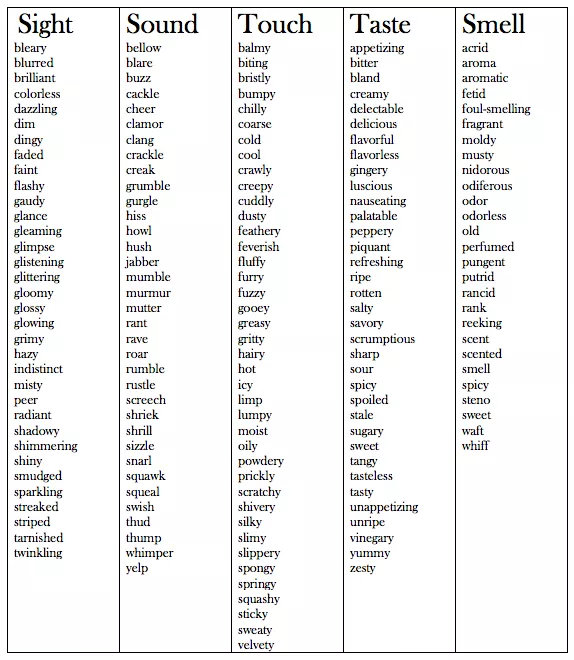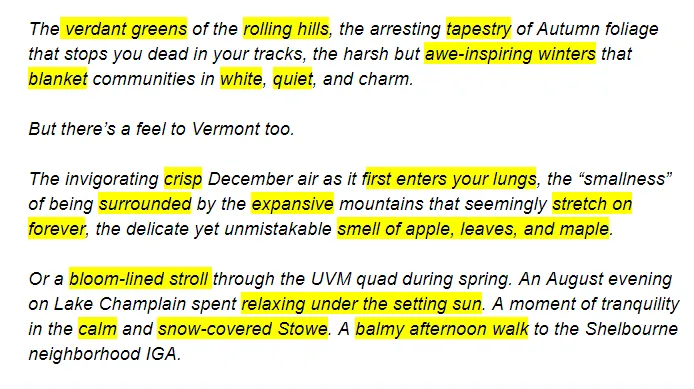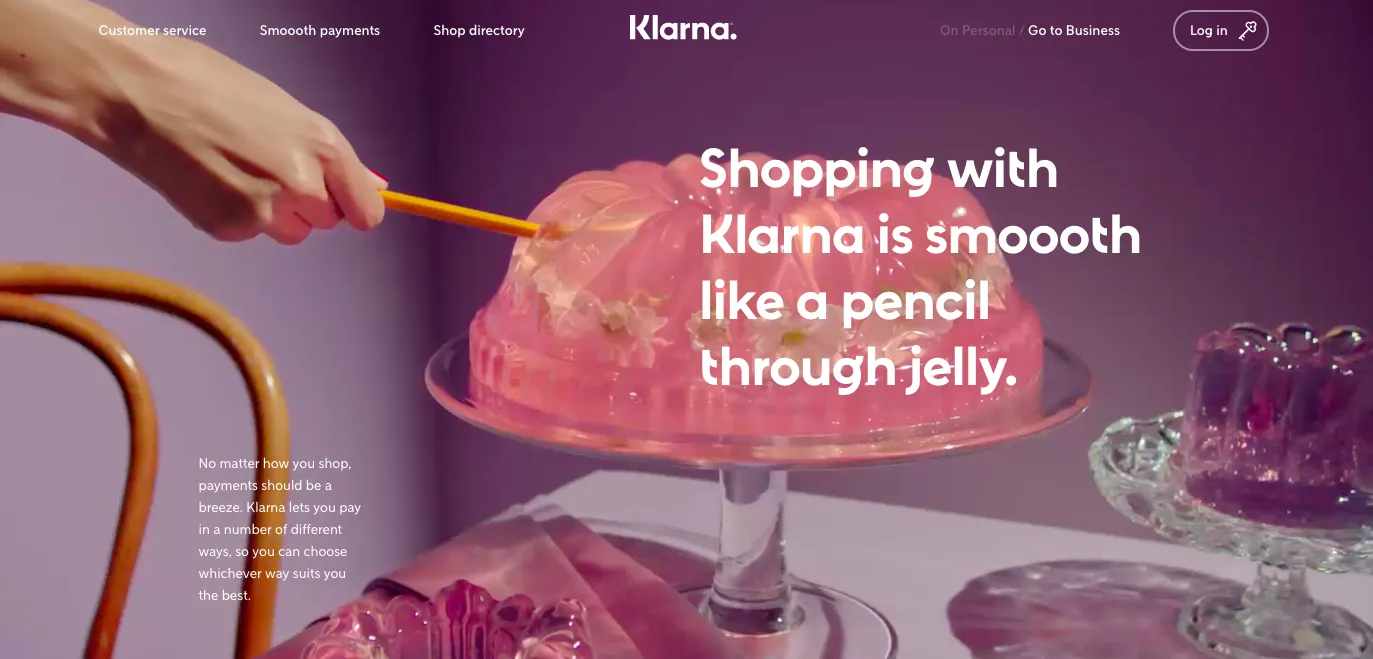5 Techniques for More Visually Engaging Copy + Actionable Tips & Real-Life Examples to Model

Social psychologist Melanie C. Green has long known that reading stories has a profound effect on people.
Stories can radically alter long-held beliefs. They can immerse you in a fully-fictional world for hours at a time. And they can permanently change the way you think.
Stories are powerful.
In fact, Green has dedicated the bulk of her academic work to uncovering why stories can have such a profound effect on the reader.
And in her studies, she discovered that one of the most important aspects of a good story is its ability to create vibrant imagery in the heads of the readers.
The more vivid the images that a story conjures up, the more a reader is bound to get lost in its pages.
Now, here’s why that’s important for marketers: vivid imagery in writing actually reduces what’s known as counterarguing.
Counterarguing is the brain’s natural ability to remain skeptical in the face of new information.
And for marketers, one of the best ways to get your viewers to buy is by eliminating counterarguing—that voice in your customers’ heads saying, “Don’t buy!”
But when you flood your copywriting with words that evoke life-like imagery in the heads of your audience, you can reduce that counterarguing and be all the more likely to close that sale.
That’s why today, I’ll show you 5 proven-to-convert tips to creating more visually engaging copy to boost your conversions. You’ll learn…
- How to use specific words and phrases to evoke vivid imagery in the minds of your target market.
- Which 2 literary techniques can keep your abstract concepts grounded and more understandable.
- What real-life examples of these techniques you can learn from and start using today.
Let’s go!
Want to delegate all your marketing and funnel work done—without the headaches of hiring? Download our free guide: 33 Marketing Projects You Can Delegate to Growbo and discover how to save 100+ hours a month, grow faster, and scale without the overhead.
#1: Appeal to Your Readers’ 5 Senses
The first (and easiest) way to paint a picture in the mind of your readers is to appeal to their 5 senses.
Now, fiction writers do this all the time. They create a world inside the heads of their audience by describing how that world feels, how it looks, and how it smells.
And as a result, those readers are transported into this fictional reality.
They achieve this effect by using what are known as sensory words—words that tend to trigger the 5 senses of the reader.
When it comes to copywriting, it can be a bit harder to achieve that effect since most of the time, your audience isn’t arriving on your site to get immersed in another world.
But that doesn’t mean it’s impossible. And as I pointed out before, the better you are at creating that “immersion” effect, the less your visitors will be able to counterargue. And the more likely they’ll be to buy.
Sight, sound, touch, taste, smell (though this last one is a bit tougher than the others)—try to use words that appeal to each to help plunge your audience into the world you’ve created.
Below is a fantastic list of sensory words from, of all places, a Tennessee middle school—who said writing’s dead in modern education?
Have a look and take a page from the book of these young writers.

Source: Rocky Fork Middle School
And to give you a better idea of how these kinds of words can all come together, here’s a brief excerpt from a landing page we wrote for one of our clients: a painter focused on capturing the unique beauty of the Vermont countryside.
The sensory words are highlighted below.

See how each of those words helps paint a highly specific and ultra-sensory picture that you practically get lost in?
And again, it’s worth mentioning that this copy was used on an actual landing page—not a short story or travel brochure.
#2: Add Personality to Your Copy
In the same way that sensory words evoke images in the mind of your readers, personality also create an image of the speaker in their minds.
And if your copy is dry, flavorless, and boring, then just like with a monotone professor, your audience is going to be far less likely to engage.
The trick, however, is to tap into the personality that your audience will respond to and write truly from that perspective.
And for some copywriters, donning that new persona can be tough. In fact, doing so poorly (especially when it comes to brands trying to engage with the younger generation) has spawned an entire subreddit devoted to the cringe-worthiness of it all.
Instead, you want to speak to your audience like a friend and close confidant, not like a mark.
David Ogilvy may have put it best when he said...
“A consumer is not a moron. She’s your wife.”
So the question is, how do you inject the right personality into your copy?
Here are a few tips to help you create the perfect personality to match the end-goal of your copy.
- Understand the Needs & Wants of Your Target Audience: It all starts here. When you truly understand what it is your audience is after, you can speak to them on equal footing rather than from a place of just wanting to sell to them.
- Get In the Mood With Some Music: Are you trying to be low-key or amped up and full of energy? Smooth and sophisticated? Or street-savvy? One way to get in the right frame of mind is by listening to the right kind of music before you sit down and write.
- Use Colloquialisms: Fam, canceled, fit, OK boomer—to be perfectly honest, I don’t know what a lot of these mean. But kids these days are using slang terms like these all the time. And if you want to approach them as a personality that truly gets who they are, you’ve got to speak as they do.
- Tap Into Emotions: As the old saying goes, people buy now based on emotions and justify later with logic. In fact, it’s why emotion is listed as one of the 11 Laws of Sales Funnel Physics. If you can tap into the emotions of your audience with your copy, you can better flesh out your brand’s personality.
#3: Nail Down the Abstract With Concrete Metaphors & Similes
If you’re a writer of any kind, you know what metaphors and similes are, right?
This is English 101 we’re talking about here.
But if not, that’s okay! Because both are super easy to learn. And super easy to use in your copywriting.
Now, both metaphors and similes are figures of speech that use easily-imaginable situations to explain abstract concepts.
However, they do so in slightly different ways.
A metaphor, for example, basically says “this abstract idea is this other easily-imaginable situation.”
Her eyes were diamonds on her face.
Life is a highway and I want to ride it all night long.
But soft, what light through yonder window breaks? It is the east, and Juliet is the sun!
That kind of stuff.
A simile, on the other hand, uses “like” or “as” to connect the abstract idea and the situation that explains it.
He was as tall as a giraffe!
Life is like a box of chocolates.
Now let me welcome everybody to the Wild Wild West, a state that’s untouchable like Eliot Ness.
The power of these techniques is in their ability to bind abstract ideas to concrete experience.
And in fact, researchers have found that people who hear matching physical language and metaphorical language (e.g., “Grasp a hand” and “Grasp a concept”) actually activate the same parts of their brain.
As such, it’s a way to reduce the mental processing required to understand an idea. Pretty cool, huh?
Now, when you use these tools in your copywriting, you can make what it is you’re selling much more memorable, more concrete, and more likely to sell.
For example, take a look at Klarna’s homepage below.

Source: StartupGrind
Klarna has two things going for it here to boost memorability.
First, it’s using a simile to connect the ease of using it (i.e., how “smoooth” it is”) to the act of putting a pencil through jelly (or rather jello).
The second thing working in Klarna’s favor here is the fact that this simile is so damn weird. It’s uncomfortable, right?
And that discomfort helps snap you out of the glazed over, unengaged internet surfing mode we’re usually all stuck in every day.
By the way, if you have a sec, give Klarna’s ad below a look. It’s basically a montage of other super apt… yet super uncomfortable comparisons of their service to strange situations.
It’s a treat.

#4: Set a Scene
Sensory words are great for conjuring up images in the heads of your audience. But sometimes, you need a little action to get the point across.
I’m not talking about the “BLAM!”s or “KABLOOEY!”s or “ZAP!”s of pre dark and broody Batman.
What I’m referencing here is the passage of time. Movement. Progress. Verbs. That kind of thing.
These are all necessary elements of effective storytelling (which can increase audience engagement by 5X).
Now, using sensory words when setting a scene is important of course since it helps build the immersion. But adding the element of time into your copy can have the dual effect of increasing a scene’s staying power and showing how your product or services can help your customers in the long run.
Let me give you an example. Below is a bit of copy we wrote for another one of our clients—this time a corporate business coach who specializes in helping busy executives stop working 60-hour weeks.
Have a look.
I remember when Alan, one of those clients, first walked into my office...
His crisp suit and confident walk told me he was a shining success in his industry. But the bags under his bloodshot eyes, the shaky hands from too much coffee, and the creases in his forehead from a constantly furrowed brow told a different story...
I saw a man who, despite his company bringing in $11 million in yearly revenue, was exhausted and feeling stuck on a 12+-hour-a-day hamster-wheel while his business bled $500,000 a year in losses.
Fast forward 10 months later—Alan’s company turned a profit. And for the first time in years, he and his wife took their first vacation in years.
Now, notice how you get sucked into the scene and watch it unfold? Here’s what we were imagining when we wrote it…
Our client is there, sitting at his desk like normal.
And then, Alan walks into the room. At first glance, he has all the confidence befitting of his role as head of a successful company.
But as the two engage more and as our client takes a closer look at him, he notices the small “tells” that everything is not as it seems. The bags under his eyes, the shaky hands, the permanent creases on his brow from too much work… it all indicates the true underlying problem: Alan is exhausted. And Alan needs help.
That’s the first passage of time in this section. And the reader is drawn into the same situation and the same realization as our client because of it.
And then there’s the “fast forward.” 10 months later, Alan’s a new man. And he finally has time to take the vacation he and his wife had always wanted, all thanks to the services of our client.
See how that works?
#5: Be Careful With Double Entendres
The double entendre (a.k.a. the double meaning) is usually reserved for shows like Married With Children, Two and a Half Men, and late-night comedies.
And they’re almost always followed by a wink wink, nudge nudge, and hooting and hollering from the studio audience (maybe real, maybe not).
But a double entendre doesn’t always have to be lightly sexual in nature. And in fact, when you do it right, it can be a fantastic way to make your copy stand out and stick in the mind of your audience.
Double meaning marketing works on a few levels.
First off, it’s clever. It’s punchy. And because of that, it’s more likely to stand out in the minds of your visitors.
But similarly to metaphor and simile, double meanings also get the point across more clearly and often more quickly.
Let’s take a look at a great example of double entendre in copywriting that you can gain some inspiration from.

Source: Creative Marketing
This ad for NYC Taxi is a great example of double entendre. Posted on the side of a bus stop, the ad implies that traveling via taxi is much faster and more reliable than waiting for the city bus.
At the same time, the action it’s referencing (raising your hand) is both signaling you don’t like waiting and signaling for a cab at the same time. Real clever stuff!
And of course, the double entendre is also highly visual. In order for you to understand the joke, you have to be able to see in your mind what raising your hand will do (signal for a cab).
This short, 7-word sentence is able to communicate all that and more without nearly any images at all. Why? Because the copy and the double meaning is highly visual.
All that being said, a double entendre should be deployed especially carefully when writing your copy.
When done well, it can carry a very clear meaning for almost everyone that views it. But when executed poorly, a double entendre can end up being confusing more than anything else.
In fact, avoiding double meaning headlines (even if they are especially visual) in favor of clarity instead is one of our 7 top tips for writing better (and more sales-worthy) headlines.
For most businesses, double entendres should be employed in less impactful areas of the copy, such as sections lower on the page. A headline is the first—and sometimes only—impression you’ll make on your visitors. So you certainly don’t want to blow it by trying to be too clever.
Conclusion
Want to delegate all your marketing and funnel work done—without the headaches of hiring? Download our free guide: 33 Marketing Projects You Can Delegate to Growbo and discover how to save 100+ hours a month, grow faster, and scale without the overhead.
So there you have it!
In this article, we covered 5 of the most useful copywriting techniques for engaging your audience with language that evokes powerful imagery.
1. Appeal to Your Readers’ 5 Senses
2. Add Personality to Your Copy
3. Nail Down the Abstract With Concrete Metaphors & Similes
4. Set a Scene
5. Be Careful With Double Entendres
With these 5 techniques, you’ll be able to spark vivid visuals for your visitors and usher them ever closer to that oh-so-important checkout page.
And if you’re ever in need of an instant, all-in-one digital marketing team to make your copy as vivid and powerful as possible, Growbo is always here to help.
Which of these 5 tips struck a chord with you the most? Which have you used in your own copywriting with great success? And do you have any other copywriting tips or techniques that are sure to inspire engaging imagery?
Let me know in the comments section below.
And as always,
Keep convertin’, stay focused.
Alex T.













